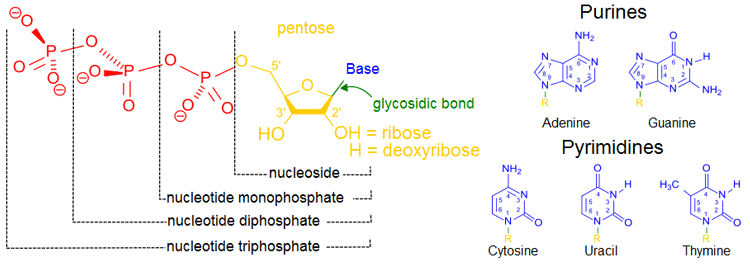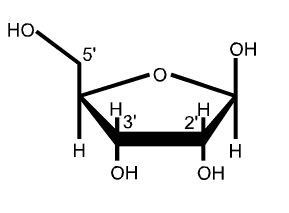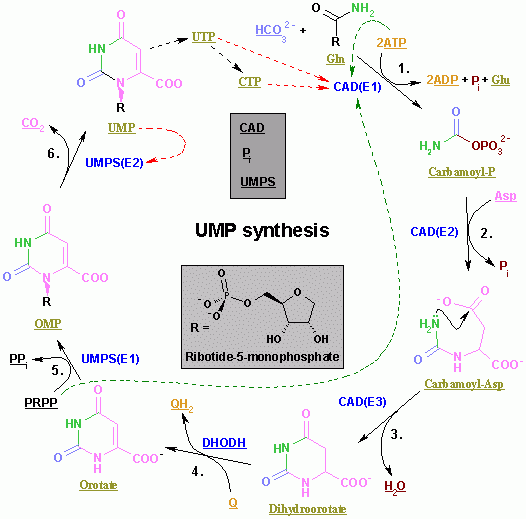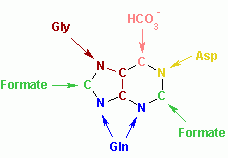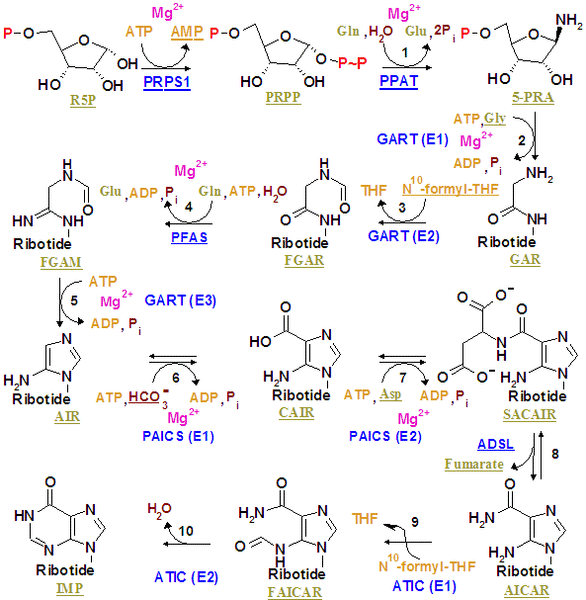Nucleotides are molecules that, when joined together, make up the structural units of RNA and DNA. In addition, nucleotides play central roles in metabolism. In that capacity, they serve as sources of chemical energy (adenosine triphosphate and guanosine triphosphate), participate in cellular signaling (cyclic guanosine monophosphate and cyclic adenosine monophosphate), and are incorporated into important cofactors of enzymatic reactions (coenzyme A, flavin adenine dinucleotide, flavin mononucleotide, and nicotinamide adenine dinucleotide phosphate).[1]
Figure 1: Structural elements of the most common nucleotides
Figure 2: Ribose structure indicating numbering of carbon atoms (*) A nucleotide is composed of a nucleobase (nitrogenous base), a five-carbon sugar (either ribose or 2'-deoxyribose), and one to three phosphate groups. Together, the nucleobase and sugar comprise a nucleoside. The phosphate groups form bonds with either the 2, 3, or 5-carbon of the sugar, with the 5-carbon site most common. Cyclic nucleotides form when the phosphate group is bound to two of the sugar's hydroxyl groups.[1] Ribonucleotides are nucleotides where the sugar is ribose, and deoxyribonucleotides contain the sugar deoxyribose. Nucleotides can contain either a purine or pyrimidine base. Nucleic acids are polymeric macromolecules made from nucleotide monomers. In DNA, the purine bases are adenine and guanine, while the pyrimidines are thymine and cytosine. RNA uses uracil in place of thymine. Synthesis Nucleotides can be synthesized by a variety of means both in vitro and in vivo. In vivo, nucleotides can be synthesised de novo or recycled through salvage pathways.[2] Nucleotides undergo breakdown such that useful parts can be reused in synthesis reactions to create new nucleotides. In vitro, protecting groups may be used during laboratory production of nucleotides. A purified nucleoside is protected to create a phosphoramidite, which can then be used to obtain analogues not found in nature and/or to synthesize an oligonucleotide. Pyrimidine ribonucleotides
The synthesis of UMP. Pyrimidine nucleotide synthesis starts with the formation of carbamoyl phosphate from glutamine and CO2. The cyclisation reaction between carbamoyl phosphate reacts with aspartate yielding orotate in subsequent steps. Orotate reacts with 5-phosphoribosyl α-diphosphate (PRPP) yielding orotidine monophosphate (OMP) which is decarboxylated to form uridine monophosphate (UMP). It is from UMP that other pyrimidine nucleotides are derived. UMP is phosphorylated to uridine triphosphate (UTP) via two sequential reactions with ATP. Cytidine monophosphate (CMP) is derived from conversion of UTP to cytidine triphosphate (CTP) with subsequent loss of two phosphates.[3] [4] Purine ribonucleotides The atoms which are used to build the purine nucleotides come from a variety of sources:
The synthesis of IMP. The de novo synthesis of purine nucleotides by which these precursors are incorporated into the purine ring, proceeds by a 10 step pathway to the branch point intermediate IMP, the nucleotide of the base hypoxanthine. AMP and GMP are subsequently synthesized from this intermediate via separate, two step each, pathways. Thus purine moieties are initially formed as part of the ribonucleotides rather than as free bases. Six enzymes take part in IMP synthesis. Three of them are multifunctional: * GART (reactions 2, 3, and 5) Reaction 1. The pathway starts with the formation of PRPP. PRPS1 is the enzyme that activates R5P, which is primarily formed by the pentose phosphate pathway, to PRPP by reacting it with ATP. The reaction is unusual in that a pyrophosphoryl group is directly transferred from ATP to C1 of R5P and that the product has the α configuration about C1. This reaction is also shared with the pathways for the synthesis of the pyrimidine nucleotides, Trp, and His. As a result of being on (a) such (a) major metabolic crossroad and the use of energy, this reaction is highly regulated. Reaction 2. In the first reaction unique to purine nucleotide biosynthesis, PPAT catalyzes the displacement of PRPP's pyrophosphate group (PPi) by Gln's amide nitrogen. The reaction occurs with the inversion of configuration about ribose C1, thereby forming β-5-phosphorybosylamine (5-PRA) and establishing the anomeric form of the future nucleotide. This reaction which is driven to completion by the subsequent hydrolysis of the released PPi, is the pathway's flux generating step and is therefore regulated too. Length unit Nucleotide (abbreviated nt) is a common length unit for single-stranded RNA, similar to how base pair is a length unit for double-stranded DNA. References 1. ^ a b Alberts B, Johnson A, Lewis J, Raff M, Roberts K & Wlater P (2002). Molecular Biology of the Cell (4th ed.). Garland Science. ISBN 0-8153-3218-1. pp. 120-121.
* Chromosome
* Abbreviations and Symbols for Nucleic Acids, Polynucleotides and their Constituents (IUPAC) Retrieved from "http://en.wikipedia.org/"
|
